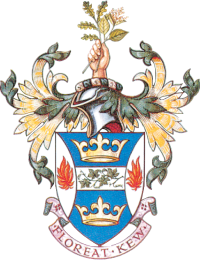Henry Harold Welch Pearson
1870 - 1916
Harold Pearson was born at Long Sutton, Lincolnshire, on 28 January 1870. After private schooling he worked as a chemist’s assistant and taught at Eastbourne, before gaining a Clothworkers’ and Leathersellers’ Exhibition that took him to Cambridge University in 1893. He was a Foundation Scholar of Christ’s College in 1896, Darwin Prizeman, and Frank Smart Student of Botany at Gonville and Gaius College in 1898. He gained a First Class in both parts of the Natural Sciences Tripos, then a BA in 1896 and an MA in 1900. A Worts’ Travelling Scholarship took him to Ceylon in 1897 where he studied high-altitude grasslands (Patanas), receiving the Walsingham Medal from Cambridge for this work. In 1898, he became assistant curator of the Cambridge herbarium.
Pearson was appointed to Kew from 1899 to 1903, first as Assistant for India, then as Assistant to the Director (W. Thistleton-Dyer). His interest in taxonomy expanded and during this time he contributed the family Verbenaceae to the Flora Capensis.
From Kew he moved to Cape Town in 1903 as Foundation Professor of Botany (established by Harry Bolus) at South African College. The first task was to plan a science block for the new department. Driven initially by a desire to study Welwitschia in the wild, he conducted extensive field work, especially in Namaqualand. His research on this plant (for which he received his doctorate in 1907) and the related genus Gnetum led to a new classification of the order Gnetales, not quite completed before his death but edited by A.C. Seward and published in 1929. His first expedition, in 1904, was cut short by an outbreak of war between the Germans and Hereros! He published an account of an expedition of 1907 in Kew Bulletin 1907: 339–360.
Pearson became the first editor of the Annals of the Bolus Herbarium, founded in 1914. A photograph of the staff of the herbarium appears in Gunn and Codd (1981) p. 96. He had a strong interest in economic botany, especially plants useful for fodder and cultivation. His efforts promoting the need for a botanic garden at the Cape came to fruition in 1913 with the establishment of the Botanic Garden at Kirstenbosch. Appointed an honorary director, he was involved in planning and laying out the garden.
Harold Pearson was a member of The Kew Guild. He was a Fellow of the Linnean Society and of the Royal Society of South Africa, and in 1916 was elected a Fellow of the Royal Society. His early death from acute pneumonia followed a minor operation. He was married but had no children.
Pearson discovered a number of new plants. He is commemorated in the legume genus Pearsonia and in the names of four species. The Harold Pearson Chair of Botany was created at Cape Town University, to be occupied by the Director of the National Botanic Gardens.
Sources
Desmond, R. (1994), Dictionary of British and Irish Botanists and Horticulturists, Taylor & Francis & The Natural History Museum, London, p. 542.
Gunn, M. & Codd, L.E. (1981), Botanical Exploration of Southern Africa …, A.A.Balkema, Cape Town.
Henry Harold Welch Pearson, Dedication in Curtis’s Botanical Magazine vol. CXL, pp 346–348, 1914.
M.S. [Matilda Smith?] (1916), In Memoriam, Henry Harold Welch Pearson, Journal of the Kew Guild. 3 (XXIII): 377–378.
